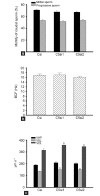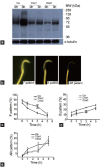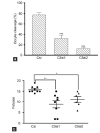An epididymis-specific carboxyl esterase CES5A is required for sperm capacitation and male fertility in the rat
- PMID: 25475668
- PMCID: PMC4650488
- DOI: 10.4103/1008-682X.143314
An epididymis-specific carboxyl esterase CES5A is required for sperm capacitation and male fertility in the rat
Abstract
Despite the fact that the phenomenon of capacitation was discovered over half century ago and much progress has been made in identifying sperm events involved in capacitation, few specific molecules of epididymal origin have been identified as being directly involved in this process in vivo . Previously, our group cloned and characterized a carboxyl esterase gene Ces5a in the rat epididymis. The CES5A protein is mainly expressed in the corpus and cauda epididymidis and secreted into the corresponding lumens. Here, we report the function of CES5A in sperm maturation. By local injection of Lentivirus -mediated siRNA in the CES5A -expressing region of the rat epididymis, Ces5a -knockdown animal models were created. These animals exhibited an inhibited sperm capacitation and a reduction in male fertility. These results suggest that CES5A plays an important role in sperm maturation and male fertility.
Figures





Similar articles
-
An epididymis-specific secretory protein HongrES1 critically regulates sperm capacitation and male fertility.PLoS One. 2008;3(12):e4106. doi: 10.1371/journal.pone.0004106. Epub 2008 Dec 31. PLoS One. 2008. PMID: 19116669 Free PMC article.
-
The ethane dimethanesulfonate-induced decrease in the fertilizing ability of cauda epididymal sperm is independent of the testis.J Androl. 1994 Jul-Aug;15(4):318-27. J Androl. 1994. PMID: 7982800
-
HongrES1, a cauda epididymis-specific protein, is involved in capacitation of guinea pig sperm.Mol Reprod Dev. 2009 Oct;76(10):984-93. doi: 10.1002/mrd.21063. Mol Reprod Dev. 2009. PMID: 19565644
-
Epididymal Binder of SPerm genes and proteins: what do we know a decade later?Andrology. 2015 Sep;3(5):817-24. doi: 10.1111/andr.12089. Epub 2015 Jul 31. Andrology. 2015. PMID: 26236016 Review.
-
New insights into epididymal function in relation to sperm maturation.Reproduction. 2013 Dec 19;147(2):R27-42. doi: 10.1530/REP-13-0420. Print 2014 Feb. Reproduction. 2013. PMID: 24218627 Review.
Cited by
-
Unraveling the phenotypic and genomic background of behavioral plasticity and temperament in North American Angus cattle.Genet Sel Evol. 2023 Jan 19;55(1):3. doi: 10.1186/s12711-023-00777-3. Genet Sel Evol. 2023. PMID: 36658485 Free PMC article.
-
Comparative RNA-Seq Analysis of Differentially Expressed Genes in the Epididymides of Yak and Cattleyak.Curr Genomics. 2019 May;20(4):293-305. doi: 10.2174/1389202920666190809092819. Curr Genomics. 2019. PMID: 32030088 Free PMC article.
-
Gynura procumbens Improved Fertility of Diabetic Rats: Preliminary Study of Sperm Proteomic.Evid Based Complement Alternat Med. 2018 Sep 30;2018:9201539. doi: 10.1155/2018/9201539. eCollection 2018. Evid Based Complement Alternat Med. 2018. PMID: 30363997 Free PMC article.
-
The proteomic landscape of sperm surface deciphers its maturational and functional aspects in buffalo.Front Physiol. 2024 Jun 28;15:1413817. doi: 10.3389/fphys.2024.1413817. eCollection 2024. Front Physiol. 2024. PMID: 39005499 Free PMC article.
-
Signatures of selection in Mulinia lateralis underpinning its rapid adaptation to laboratory conditions.Evol Appl. 2024 Feb 14;17(2):e13657. doi: 10.1111/eva.13657. eCollection 2024 Feb. Evol Appl. 2024. PMID: 38357357 Free PMC article.
References
-
- Jones RC. To store or mature spermatozoa? The primary role of the epididymis. Int J Androl. 1999;22:57–67. - PubMed
-
- Orgebin-Crist MC. Sperm maturation in rabbit epididymis. Nature. 1967;216:816–8. - PubMed
-
- Visconti PE, Moore GD, Bailey JL, Leclerc P, Connors SA, et al. Capacitation of mouse spermatozoa. II. Protein tyrosine phosphorylation and capacitation are regulated by a cAMP-dependent pathway. Development. 1995;121:1139–50. - PubMed
Publication types
MeSH terms
Substances
LinkOut - more resources
Full Text Sources
Molecular Biology Databases

